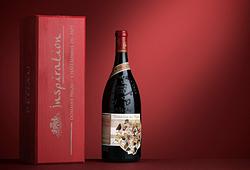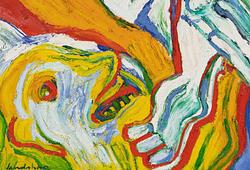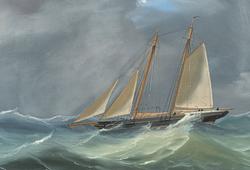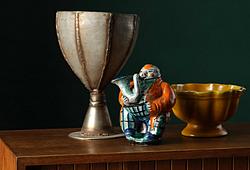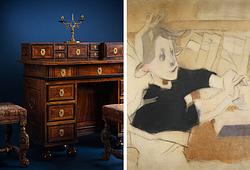Bruno Liljefors
Kitten in the grass
Signed Bruno Liljefors and dated Qvarnbo -84. Panel 22 x 15,5 cm.
Provenance
The artist's family. Thence by descent.
More information
When Bruno Liljefors returned to Sweden from France in the mid-1880s, he settled in Kvarnbo outside Uppsala, where he found inspiration for his early delicate depictions of the Swedish flora and fauna. He soon developed into one of his era's most promising and innovative artists. It is also during this time that the cat Jeppe enters Liljefors' life. The artist recounts their first meeting in the book "De vildas rike":
"Once, when I was young, I came home from hunting with a capercaillie that I had shot. I was staying in a farmhouse. A little kitten was playing on the floor where I threw the capercaillie. At first, he ran like lightning under the bed, but soon he was out again, approached cautiously, and then firmly grabbed her by the neck and dragged the heavy bird backwards under the bed. The kitten was just the type I liked, earth-gray with darker stripes and no white. When I moved, I received the cat as a gift and we became inseparable."
Jeppe the cat not only became Liljefors' companion but also his best friend. As soon as he took the shotgun off the wall, Jeppe would jump with joy to accompany him into the wilderness. When Liljefors was away, Jeppe would meet him a couple of kilometers from home to escort him back. The gray-striped cat, his own Jeppe, became a famous model over the years. He was depicted either pleasantly relaxed in the green grass or, even more so, as the cunning hunter. Liljefors' photographic memory helped him depict the animal in motion during hunting and fleeing. The animal models are said to have had an instinctive trust in Liljefors when it was time for portrayal; he always portrayed his models as individuals and gladly explained, "I paint animal portraits." He was also one of the first artists to successfully integrate animals into their natural environment.
The portrait of the little kitten, probably not Jeppe, was painted in Kvarnbo in 1884 and thus created during the period that is now considered Bruno Liljefors' most famous and desirable. Painting "en plein air" with strong elements of japonism and French impressionism testifies to his time in France. The close contact with the model, seen from a skewed frog's perspective, is palpable. The little kitten sits completely still, watching the artist with an intense and exploratory gaze. The variations in the soft fur are so realistic that one is tempted to reach out between the strands of grass to stroke the soft head with one's hand. It is an idyllic image - but illusory, as even a young cat can quickly strike at suitable prey if given the opportunity.
Artist
Bruno Liljefors is the Swedish artist best known for his nature and animal motifs, especially in dramatic situations. Liljefors started with studies at the Academy of Arts in 1879, and continued 1882 in Düsseldorf where the studies revolved around animal painting. The journey then continued to Venice, Rome, Naples, Paris and Grez. Once back in Sweden, he began to draw and paint animals, especially cats and small birds, from the beginning in intimate interaction with nature. He then moved on to broader depictions of wild animals and nature, of seascapes with seabirds and of dramatic scenes of battles between birds. Liljefors is known as our country's foremost animal painter with a large production. Liljefors depicted, in contrast to the "idyllic" animal painting, the animals everyday life with a focus on movement, anatomy and their adaptation to the landscape. This is where the greatness of his painting lies, in the ability to show the animals in their proper environment. He has achieved this by hunting and observing. Well-known works of art are the paintings "Rävfamilj" (1886) and "Havsörnar" (1897), as well as the sculpture "Lek" (1930) at Stockholm Stadium. Liljefors is mainly represented at the National Museum, Waldemarsudde and the Thielska gallery in Stockholm.
Read more



